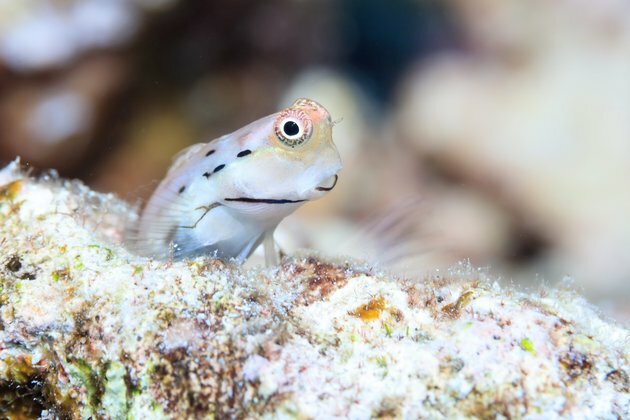Snack-sized 'candy' fish explain a coral mystery
The Conversation
24 May 2019, 02:03 GMT+10

You're swimming over a coral reef. What do you see? Most people will reply: fish. On a coral reef, fish are large, abundant, gaudily coloured and in-your-face impossible to miss. The waters around coral reefs must be incredibly rich to support such an abundance of life, right? But that is not the case at all. This contradiction is a long-standing ecological puzzle known as Darwin's paradox.
In the 1830s, Darwin wondered how coral reefs, so bountiful with life, could thrive in areas of the tropical Pacific that were seemingly barren. Although Darwin couldn't actually measure nutrients in the water, he was right about the apparent barrenness. There are almost no detectable nutrients in the water around coral reefs, which is why it is so clear and blue. It's quite a contrast with the green soup that characterises the summertime coastal waters of British Columbia or Nova Scotia. There, an abundance of nutrients fuels the growth of small plants, called phytoplankton, at the bottom of the marine food chain.
Clearly, tropical waters around coral reefs must be tapping into some unseen source of energy. Scientists now know that some nutrients do arrive onto coral reefs from nearby land via rock erosion, seabird guano and, increasingly, human activities, to be taken up quickly by phytoplankton that is retained around reefs.
Snack-sized bites
This phenomenon, called the Island Mass Effect, is prevalent near islands and atolls around the world. However, our new study reveals that the breakfast, lunch and dinner plates of reef fishes are also filled by another unlikely and almost universally overlooked source of food that makes these nutrients available: tiny fishes.
Tiny, camouflaged, bottom-dwelling (cryptobenthic) fishes don't sound like anything to write home about. Anybody casually snorkelling or diving on a reef will see no more of them than brief, barely perceptible flashes of red, white, black, orange, yellow, green or purple as the fish frantically skedaddle to safety among the nooks and crannies of the reef.
Tiny fish rarely exceed 50 mm as adults, and most of them are just half this size. They are distributed across 17 families of reef fishes. Some of the more famous ones, like a few species of gobies, blennies and cardinalfishes, make frequent appearances in hobby saltwater aquaria, but the rest (probably up to 4,000 or so) are rarely noticed.
As aficionados of small fish, we are of course biased, but these miniature fishes are absolutely beautiful. They sport all manner of dots, stripes, bars, speckles, blotches and squiggles, in almost all colours of the rainbow. They also have an astounding array of social and reproductive behaviours, ranging from pairing up with shrimps for safety to brooding eggs in their mouths. Some even have the ability to change sex in either direction and back and forth! But because they are outside of the size range that immediately grabs our attention, few people have been interested in these tiny fishes.
Until now...
Small but mighty
How are tiny fish a source of energy for coral reefs? They die. And they do so in droves. These fish will never threaten Methuselah's longevity record: some never get older than 59 days, because they get eaten so swiftly. So why don't reefs run out of tiny fish?
The answer lies in the larval stage. Most marine fishes spend their early life - a few days to several weeks - as small larvae in the water column that drift away from where they were spawned. We discovered that about three-quarters of all reef fish larvae near coral reefs are from cryptobenthics, which is an unexpectedly high proportion given the modest reproductive output of tiny fishes. They are able to do this because, instead of having their newly spawned offspring venture into the endless open ocean where food is scarce and predators plentiful, cryptobenthic larvae appear to linger close to the reefs, avoiding the deadly dangers of the open ocean.
Exactly how the tiny fish larvae do this is still a mystery, but it has dramatic consequences for coral reefs. By creating a hyper-abundant reservoir of offspring that can immediately replace each devoured adult, the tiny fish and their rapid turnover account for approximately 60 per cent of the fish flesh consumed on reefs, as we reveal in a theoretical population model that tracks the fate of larvae from settlement to death.
In essence, these tiny little fish are like candy in a bottomless jar, placed in the office lunchroom. Everybody will happily grab a handful, but instead of depleting the candy, the jar magically replenishes every time a few pieces of candy are snagged. A near-inexhaustible source of candy fish that are casually devoured by many hungry mouths.
Our discovery means that we might have to rethink what the best actions are to conserve coral reefs and their abundant resources in the long term. Right now, the very large fish like sharks or groupers, get most of the attention. Large stretches of coastal ocean, including swathes of coral reefs, have been declared off-limits to fishing to protect these species.
While protection of species targeted by fisheries is important, sharks and all the reef fishes that people like to find on their dinner plates (and, in many places of the world, rely on for their livelihoods), ultimately depend on the tiniest fishes and their mass-production population dynamics. What works in terms of protection for one end of the food chain might not be so useful for the other end. Perhaps it's time to put our thinking caps on and figure out how to protect the smallest fishy citizens of the reef and the critical service they provide.
Authors: Simon Brandl - Postdoctoral research fellow, Simon Fraser University | Isabelle CУТДtУТЉ - Professor of Marine Ecology, Simon Fraser University 
 Share
Share
 Tweet
Tweet
 Share
Share
 Flip
Flip
 Email
Email
Watch latest videos
Subscribe and Follow
Get a daily dose of Birmingham News news through our daily email, its complimentary and keeps you fully up to date with world and business news as well.
News RELEASES
Publish news of your business, community or sports group, personnel appointments, major event and more by submitting a news release to Birmingham News.
More InformationBusiness
SectionAmazon’s Zoox unveils plan to build 10,000 robotaxis a year
HAYWARD, California: In a significant step toward its commercial debut, Amazon-owned Zoox has unveiled its first factory dedicated...
Brazil aims to restart poultry trade after bird flu clearance
SAO PAULO, Brazil: Brazil is taking confident steps to restore its dominance in global poultry exports after declaring its commercial...
U.S. stocks restricted by tensions in Middle East
NEW YORK, New YorK - U.S. stocks closed mixed on Friday, with gains and losses modest, as investors and traders weighed up the escalation...
US consumers cut back after early surge ahead of Trump tariffs
WASHINGTON, D.C.: Retail sales dropped sharply in May as consumer spending slowed after a strong start to the year, primarily due to...
Mitsubishi joins automakers raising prices after import tariffs
WASHINGTON, D.C.: Mitsubishi Motors is the latest automaker to raise prices in the United States, joining a growing list of car companies...
Lilly makes $1.3 billion move to expand into gene-edited heart drugs
INDIANAPOLIS, Indiana: Eli Lilly is making a bold play in cardiovascular gene therapy, announcing plans to acquire its partner Verve...
United Kingdom
SectionStarmer: US-UK trade deal to be finalized 'very soon.'
KANANASKIS, Alberta: With key tariff deadlines approaching, British Prime Minister Keir Starmer said this week that finalizing the...
Blaise Metreweli becomes first woman to head MI6
LONDON, U.K.: On June 15, Britain named Blaise Metreweli as the first woman to lead the Secret Intelligence Service, commonly known...
Flight recorder may reveal cause of deadly crash of Air India Boeing
NEW DELHI, India: The flight data recorder from the crashed Air India plane was found on June 13. This vital discovery may help investigators...
Nottingham Forest manager Nuno Espirito Santo signs three-year contract extension until 2028
Nottingham [UK], June 21 (ANI): Nottingham Forest on Saturday announced a three-year contract extension of manager Nuno Espirito Santo...
Instant retail reshapes consumption habits in China, driving new growth
NANNING, June 21 (Xinhua) -- In the charming countryside of south China's Guangxi Zhuang Autonomous Region, Alex Turner, a British...
Air India issued show-cause notice for two flights exceeding stipulated flight time limit, 3 officials removed for rostering violations
New Delhi [India], June 21 (ANI): The Directorate General of Civil Aviation (DGCA) has issued a show cause notice to the Accountable...













